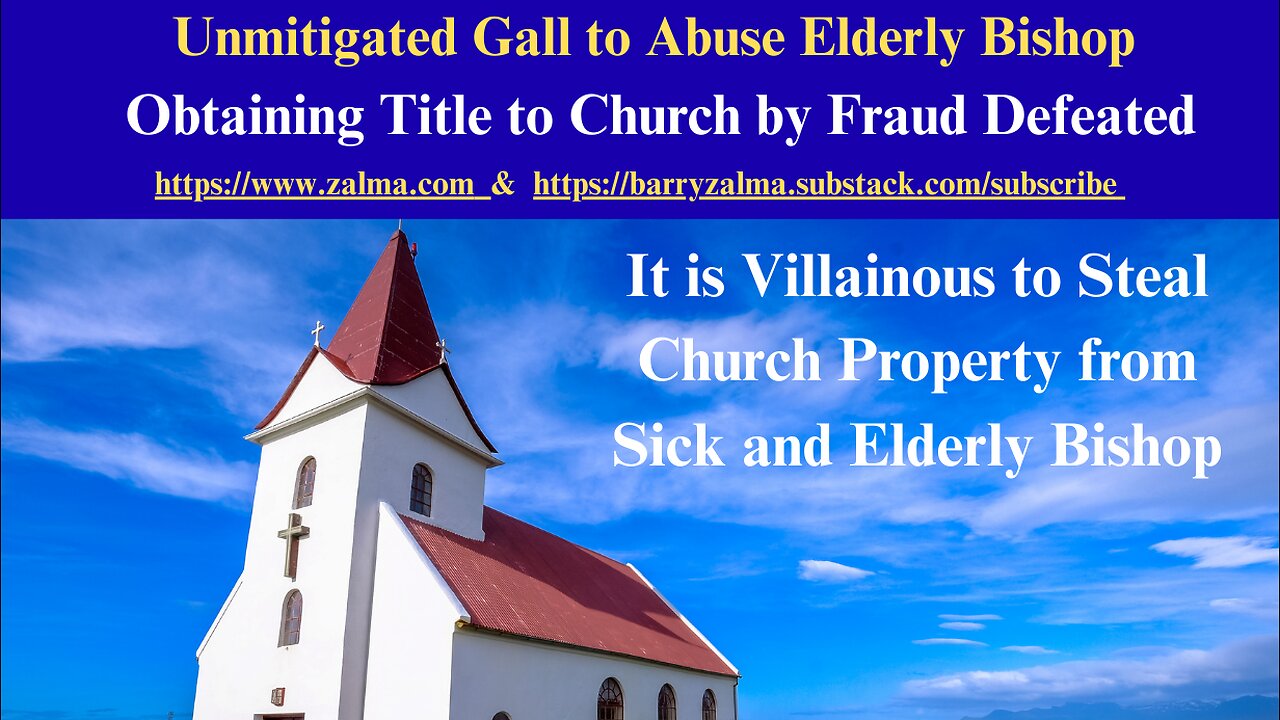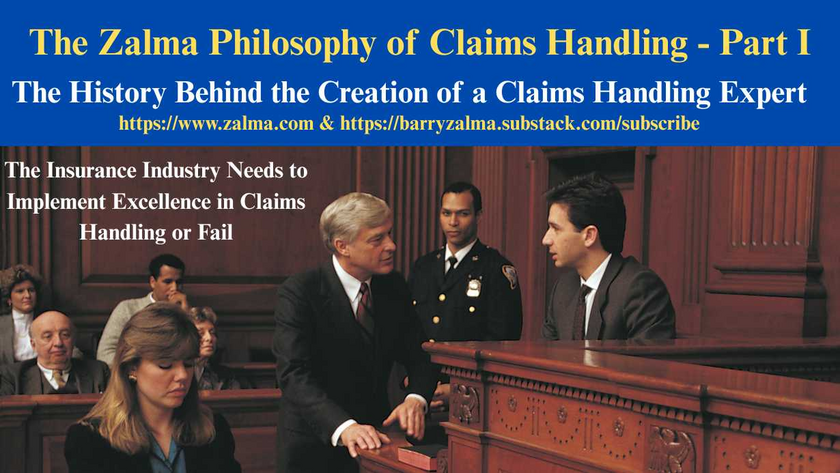
First Party Property Losses
What is Required of a Claims Department After a Claim is Presented When Faced With Loss Report
Barry Zalma
Jan 29, 2024
See the full article at https://www.linkedin.com/.../first-party-property-losses.../; See the full video at https://lnkd.in/gGnZtzDc and at https://lnkd.in/grSNtjpv the full article at https://lnkd.in/g35ZtdSj and see the full video at https://lnkd.in/gGnZtzDc and at https://lnkd.in/gBd4WX7q and at https://zalma.com/blog plus more than 4700 posts.
What is Required of a Claims Department After a Claim is Presented When Faced With Loss Report
Post 4722
Every claim begins with receipt of the Notice Of Loss
A Notice of Loss is a written or oral report to the insurer that the insured has incurred a loss. It advises the insurer that it has incurred a loss due, with respect to the insured, a wildfire to one or more properties the risk of loss of which was insured. The loss notice will advise the insurer:
1 The name, address and telephone number and/or email address of the person most knowledgeable.
2 The date and time of the loss.
3 The location(s) of the loss
4 The cause of the loss e.g., wildfire, flood, earthquake, vandalism, or major theft.
After the insurer receives a Notice of Loss the insurer is required by the custom and practice of professional claims handling and the requirements of the California Fair Claims Settlement Practices statute and Regulations to enforce the statute, the insurer must acknowledge receipt of the Notice of Loss in writing immediately but in no event more than 15 calendar days.
The acknowledgement letter must also include advice to the insured on the coverage available. To properly acknowledge the notice of loss the claims person must obtain a complete copy of the policy, read and analyze the policy and create a summary of the coverages available.
California Fair Claims Settlement Practice Regulations Section 2695.4, for example, provides “Every insurer shall disclose to a first party claimant or beneficiary, all benefits, coverage, time limits or other provisions of any insurance policy issued by that insurer that may apply to the claim presented by the claimant. When additional benefits might reasonably be payable under an insured’s policy upon receipt of additional proofs of claim, the insurer shall immediately communicate this fact to the insured and cooperate with and assist the insured in determining the extent of the insurer’s additional liability.”
The letter should include, as a bare minimum, information like:
1 the limits of liability of the policy,
2 any deductibles or self-insured retentions,
3 advice concerning any specific exclusions or conditions that apply to the facts established by the notice of loss,
4 a written notice that a proof of loss is required within 60-days of the letter with an attached proof of loss form,
5 a requirement for the production of necessary documents,
6 a reservation of rights (if called for), and
7 any other information the insured needs to fulfill the conditions of the policy.
The letter should include, because a wildfire’s damages are almost always serious, and realize that to an individual any claim is serious, and should include confirmation by the claims person of an appointment to meet with the insured to view the damaged property(ies).
The inspection should be as soon as possible but no later than 15 calendar days after the notice of loss. The inspection should include the creation of a scope of loss. The scope of loss the claims person prepares should be written in the same form as a professional contractor that the claims person has determined is acceptable to a professional contractor. The adjuster should contact several reconstruction contractors who are willing to do reconstruction work for detail on the claims person’s scope. The adjuster must understand that standard prices in software like Xactimate will change in a catastrophe situation because of the shortage of people and materials available to repair structures. The agreed scope of loss should include all damages incurred by the insured to real and personal property, equipment, stock, merchandise, inventory, appurtenant property, plants, trees, shrubs, etc.
The Scope of Loss
The scope of a major loss will often be recorded and later transcribed especially when there is major damage and multiple properties and types of property. The scope of a major loss can be multiple pages and supplemented with photos and videos of the loss location(s). The scope is not an estimate nor is it an adjustment, it is an outline of the damages that the insured and the adjuster agree the items that need to reach a later agreement after a thorough investigation the full amount of loss can be determined. The Scope of Loss is the beginning of the thorough investigation of the claim that is required to be commenced immediately but in no event more than 15 calendar days after the receipt of a notice of loss.
The Thorough Investigation
A thorough investigation is a thorough investigation is conducted for each claim sufficient to allow a determination of coverage, the liability of the insured, the nature and extent of damages, or the obligations of the insurer or surety. An investigation is not sufficient if the work of the claims handler is limited to a mere reading the policy and comparing it to a loss notice. Once a scope of loss is agreed it is the obligation of the insurer to obtain estimates from:
1 contractors
2 construction experts to put a dollar amount on the structure losses.
3 If personal property is involved the scope details the property damaged or destroyed and once agreed obtain estimates from:
4 personal property or equipment experts
5 personal property values.
6 If there are time element losses once the scope of the loss is agreed the insured and insurer will work together with a CPA or forensic accountants to establish the extent to which time element losses have occurred.
Depending on the extent of the loss it is essential that the claims department work, preferably in person, in establishing a scope of loss.
The Proof of Claim
The claims person must then work closely with the insured to reach agreement as to the amount of loss and damage.
Once the insured presents a “proof of claim” as defined in the California Fair Claims Practices Regulations: “’Proof of claim’ means any evidence or documentation in the possession of the insurer, whether as a result of its having been submitted by the claimant or obtained by the insurer in the course of its investigation, that provides any evidence of the claim and that reasonably supports the magnitude or the amount of the claimed loss.” [Regulations, Section 2695.2 (s)]
A “proof of claim” is not a sworn statement in proof of loss required by almost all first-party property insurance policies as a condition precedent to indemnity.
Rather, it is something less than a proof of loss and, if the insurer wants a proof of loss, it must demand it in writing in accordance with the policy wording.
The insurer must still respond promptly (within the time limits set by the Regulations) to the proof of claim. Failure to do so would be an obvious and clear violation of the Regulations.
The claims person is not required to accept or reject the claim within 40 calendar days but must respond to the presentation of the proof of claim either accepting, rejecting or advising the insured/claimant that the insurer needs further investigation and time to respond to the proof of claim.
If investigation is needed to respond to the proof of claim it is necessary to repeat, every 30 days, an explanation why the insurer is unable to respond to the proof of claim and when it expects to be able to properly respond.
If the insurer agrees to the “proof of claim” the amount stated becomes undisputed and payment is required immediately but in no event more than 40 calendar days from the date the “proof of claim” becomes undisputed.
It is the obligation of the claims personnel to work to resolve the claim promptly and as soon as reasonably practicable.
The “proof of claim” is a starting point from which the insurer and the insured can get a total resolution.
If they cannot agree the insured and the insurer have options to assist. The insurer must advise the insured what additional information it needs to conclude the claim. The Regulations require that the insurer advise the insured what is needed and how much time it will take them to resolve the claim(s). The insurer is obligated to do so every 30 calendar days.
The Poof of Loss
Unlike the “proof of claim” the policy requires a proof of loss to resolve a claim. A “proof of loss” is usually a means of reciting the agreement between the insured and the insurer as to the amount of loss. If an agreement cannot be reached, once demanded, the insured must submit its proof of loss.
After the insured’s proof of loss is received the insurer must, immediately but no later than 30 calendar days after receipt, its agreement, disagreement, acceptance, or refusal of the proof of loss explaining in detail the reason why the proof of loss is not acceptable, what is needed to be acceptable, and how much time the insurer needs to resolve the claim(s). The insurer can require, as part of the proof of loss that the insured or its employees submit to an examination under oath. Once the transcripts are signed and delivered to the insurer it must respond to the full proof of loss immediately but in no event more than 30 calendar days.
(c) 2024 Barry Zalma & ClaimSchool, Inc.
Please tell your friends and colleagues about this blog and the videos and let them subscribe to the blog and the videos.
Subscribe to my substack at https://barryzalma.substack.com/publish/post/107007808
Go to Newsbreak.com https://www.newsbreak.com/@c/1653419?s=01
Go to X @bzalma; Go to the podcast Zalma On Insurance at https://podcasters.spotify.com/pod/show/barry-zalma/support; Go to Barry Zalma videos at Rumble.com at https://rumble.com/c/c-262921; Go to Barry Zalma on YouTube- https://www.youtube.com/channel/UCysiZklEtxZsSF9DfC0Expg; Go to the Insurance Claims Library – http://zalma.com/blog/insurance-claims-library.
Please tell your friends and colleagues about this blog and the videos and let them subscribe to the blog and the videos. Subscribe to my substack at https://lnkd.in/gus8Mzkq; the Insurance Claims Library – https://lnkd.in/gwEYkxD; Go to X @bzalma; Go to Rumble.com at https://lnkd.in/gV9QJYH.
When Harm is Inherent in the Nature of the Act it is Intentional
Post 5237
See the video at and at and at https://zalma.com/blog plus more than 5200 posts.
No Coverage for Intentional Acts
Hitting a Person in the Face is an Intentional Act
In Unitrin Auto and Home Insurance Company v. Brian C. Sullivan, et al., George A. Ciminello, No. 2022-01607, Index No. 21632/14, Supreme Court of New York, Second Department (November 19, 2025) George A. Ciminello was injured when struck in the face by a cup filled with liquid, thrown from a moving vehicle operated by Brian C. Sullivan, with Robert Harford as the passenger who threw the cup. The vehicle approached Ciminello at about 30 mph, from 2 to 10 feet away, and Harford extended his arm to make contact. The cup splintered upon impact.
Sullivan and Harford later conceded liability on the intentional tort claim before a damages trial.
Insurance Policy:
Unitrin Auto and Home...

Obtaining Title to Church by Fraud Defeated
Post 5238
Read the full article at https://www.linkedin.com/pulse/unmitigated-gall-abuse-elderly-bishop-his-church-zalma-esq-cfe-xcasc, see the video at and at and at https://zalma.com/blog plus more than 5200 posts.
It is Villainous to Steal Church Property from Sick and Elderly Bishop
In Testimonial Cathedral Local Church of God in Christ v. EquityKey Real Estate Option, LLC et al. (Cal. Ct. App., 2d Dist., Div. 8, No. B331522 (Nov. 18, 2025) EquityKey (through broker Steven Sharpe and Frank Wheaton, a trusted advisor/friend of elderly Bishop Jimmy Hackworth) presented a deal supposedly for a $4 million life-insurance policy on Hackworth’s life with EquityKey as beneficiary. In exchange, EquityKey paid Hackworth $400,000 upfront.
Factual Background
To qualify Hackworth for the large policy, church real property on South Western Ave., Los Angeles was temporarily ...

Guilty of Money Laundering Scheme
Post 5238
See the video at https://lnkd.in/gqh7V46x and at https://lnkd.in/gmE-zrDC and at https://zalma.com/blog plus more than 5200 posts.
Prison Sentence for Fraud Must be Limited to the Fraud in Which the Defendant Participated
In United States v. Stephen O. Anagor, No. 2:24-CR-00019-DCLC-CRW (E.D. Tenn., Nov. 26, 2025) by Judge Clifton L. Corker the government sought to increase the defendant’s sentence because his co-conspirators added a fraudulent FBI scam that resulted in the victim’s suicide. Anagor sought a lower sentence because he was only involved in part of the fraud.
Charges & Plea
Defendant, a U.S. Army soldier pled guilty on June 11, 2025 to Conspiracy to Commit Mail and Wire Fraud, Aiding and Abetting Aggravated Stalking Resulting in Death and Aiding and Abetting Aggravated Identity Theft that was part of a larger 38-count superseding indictment against Anagor and co-defendants Chinagorom Onwumere and Salma Abdalkareem for an international Nigerian-based ...
The Professional Claims Handler
Post 5219
Posted on October 31, 2025 by Barry Zalma
An Insurance claims professionals should be a person who:
Can read and understand the insurance policies issued by the insurer.
Understands the promises made by the policy.
Understand their obligation, as an insurer’s claims staff, to fulfill the promises made.
Are competent investigators.
Have empathy and recognize the difference between empathy and sympathy.
Understand medicine relating to traumatic injuries and are sufficiently versed in tort law to deal with lawyers as equals.
Understand how to repair damage to real and personal property and the value of the repairs or the property.
Understand how to negotiate a fair and reasonable settlement with the insured that is fair and reasonable to both the insured and the insurer.
How to Create Claims Professionals
To avoid fraudulent claims, claims of breach of contract, bad faith, punitive damages, unresolved losses, and to make a profit, insurers ...

The History Behind the Creation of a Claims Handling Expert
The Insurance Industry Needs to Implement Excellence in Claims Handling or Fail
Post 5210
This is a change from my normal blog postings. It is my attempt. in more than one post, to explain the need for professional claims representatives who comply with the basic custom and practice of the insurance industry. This statement of my philosophy on claims handling starts with my history as a claims adjuster, insurance defense and coverage lawyer and insurance claims handling expert.
My Training to be an Insurance Claims Adjuster
When I was discharged from the US Army in 1967 I was hired as an insurance adjuster trainee by a professional and well respected insurance company. The insurer took a chance on me because I had been an Army Intelligence Investigator for my three years in the military and could use that training and experience to be a basis to become a professional insurance adjuster.
I was initially sat at a desk reading a text-book on insurance ...

The History Behind the Creation of a Claims Handling Expert
The Insurance Industry Needs to Implement Excellence in Claims Handling or Fail
Post 5210
This is a change from my normal blog postings. It is my attempt. in more than one post, to explain the need for professional claims representatives who comply with the basic custom and practice of the insurance industry. This statement of my philosophy on claims handling starts with my history as a claims adjuster, insurance defense and coverage lawyer and insurance claims handling expert.
My Training to be an Insurance Claims Adjuster
When I was discharged from the US Army in 1967 I was hired as an insurance adjuster trainee by a professional and well respected insurance company. The insurer took a chance on me because I had been an Army Intelligence Investigator for my three years in the military and could use that training and experience to be a basis to become a professional insurance adjuster.
I was initially sat at a desk reading a text-book on insurance ...














